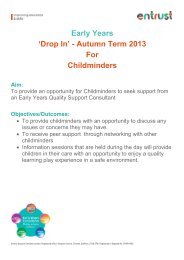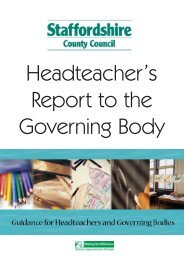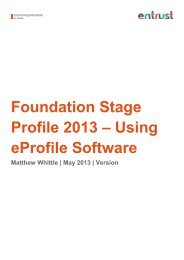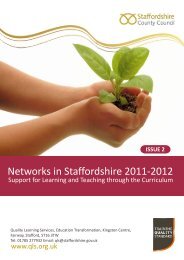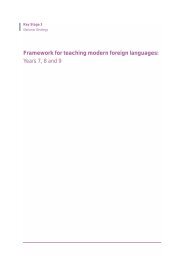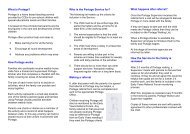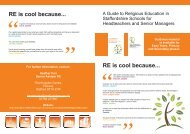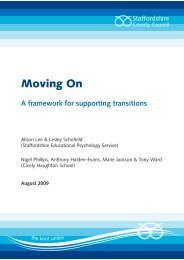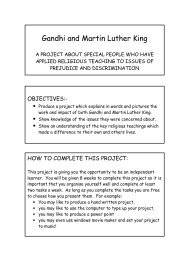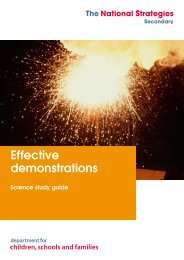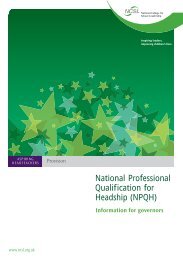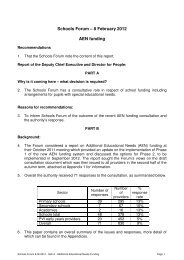Reading skills_save for pdf - Staffordshire Learning Net ...
Reading skills_save for pdf - Staffordshire Learning Net ...
Reading skills_save for pdf - Staffordshire Learning Net ...
You also want an ePaper? Increase the reach of your titles
YUMPU automatically turns print PDFs into web optimized ePapers that Google loves.
<strong>Reading</strong>: Level 5 Focus<br />
READING 5 4A - Upper 4 5C - Lower 5 5B - Secure 5 5A - Upper 5 Level 6<br />
Confidently uses a full range of strategies<br />
to attempt to read any new text fluently and<br />
accurately.<br />
Uses a full range of strategies to read a<br />
wide range of texts fluently and accurately.<br />
Understands use of connectives as<br />
signposts to indicate a change of tone,<br />
voice, opinion – and applies this to maintain<br />
understanding when reading specific types<br />
of text.<br />
Uses a full range of strategies to read a<br />
range of texts fluently and accurately.<br />
Uses word derivations and word<br />
<strong>for</strong>mation,(e.g. prefixes, acronyms and<br />
letter omission), to construct meaning of<br />
words in context across a range of texts.<br />
Reads fluently and accurately,<br />
demonstrating an understanding of<br />
more sophisticated punctuation<br />
(e.g. colon, semi-colon, parenthetic<br />
commas, dashes, brackets).<br />
Book Bands<br />
Assessment Focus1<br />
Use a range of strategies, including<br />
accurate decoding of text, to read<br />
<strong>for</strong> meaning<br />
Summarises a range of<br />
in<strong>for</strong>mation from different<br />
sources.<br />
Responses clearly identify and explain<br />
most of the relevant points, supported by<br />
appropriate references to text.<br />
Reflects on the implications of events,<br />
actions and feelings in order to explain<br />
them fully.<br />
Shows understanding of a range of<br />
texts, selecting essential points where<br />
appropriate.<br />
In responses, identifies key themes and<br />
characters.<br />
Retrieves and collates in<strong>for</strong>mation from<br />
a range of sources.<br />
Responses and comments are usually<br />
supported by relevant references to text.<br />
Decides on quality and usefulness of<br />
text by skim-reading to gain an overall<br />
impression.<br />
Explains points or opinions and<br />
usually includes some specific<br />
references to text.<br />
Uses <strong>skills</strong> of skimming, scanning<br />
and text marking to locate relevant<br />
in<strong>for</strong>mation quickly and effectively.<br />
Assessment Focus 2<br />
Understand, describe, select or<br />
retrieve in<strong>for</strong>mation, events or<br />
ideas from texts and use quotation<br />
and reference to text<br />
In reading and discussing a range<br />
of texts, identifies different layers<br />
of meaning and comments on their<br />
significance and effect.<br />
Provides reasoned explanation <strong>for</strong> inferred<br />
meaning, drawing on a range of evidence<br />
from the text.<br />
Recognises and responds to text<br />
complexity, recognising layers of meaning.<br />
Shows understanding of a range of texts<br />
using inference and deduction where<br />
appropriate.<br />
Distinguishes between implicit and<br />
explicit points of view.<br />
Explains how messages, moods,<br />
feelings and attitudes are conveyed in<br />
poetry and prose, using inference and<br />
deduction and making some reference<br />
to text.<br />
Infers meaning based on evidence<br />
drawn from different points in text.<br />
Assessment Focus 3<br />
Deduce, infer or interpret<br />
in<strong>for</strong>mation, events or ideas from<br />
texts<br />
Explains implicit and explicit points of view.<br />
Gives personal responses to<br />
literary texts, referring to aspects<br />
of structure in justifying their<br />
views.<br />
Explains how an author’s use of genrespecific<br />
language features supports the<br />
writer’s theme or purpose.<br />
Explains impact and effectiveness of<br />
structural devices used by author to<br />
organise text.<br />
In responses, identifies key features.<br />
Identifies author’s use of genre- specific<br />
language to convey in<strong>for</strong>mation in nonfiction<br />
texts.<br />
Identifies specific structural devices used<br />
by author to organise text, with some<br />
awareness of impact.<br />
Uses secure understanding of<br />
structure and language features of<br />
fiction and full range of non-fiction<br />
text types to support understanding<br />
when reading extended texts or from<br />
a range of sources.<br />
Assessment Focus 4<br />
Identify and comment on the<br />
structure and organisation of texts,<br />
including grammatical and literary<br />
features at text level<br />
15<br />
Comments on author’s use of genre-specific<br />
language to convey in<strong>for</strong>mation across a<br />
range of non-fiction texts<br />
Comments on specific structural devices<br />
used by the author to organise text, with<br />
some explanation of effectiveness.<br />
Gives personal responses to<br />
literary texts, referring to aspects<br />
of language and themes in<br />
justifying their views.<br />
Explains effectiveness and impact on<br />
reader of writer’s language choices.<br />
Recognises when a word or phrase has<br />
more than one layer of meaning and<br />
explains this precisely.<br />
Identifies some basic features of writer’s Selects sentences, phrases and relevant<br />
language choices, with some<br />
in<strong>for</strong>mation to support views.<br />
explanation. Comments on writer’s language choices,<br />
showing some awareness of effect on<br />
reader.<br />
Compares and contrasts the styles of<br />
different writers and poets, giving<br />
examples from texts.<br />
Assessment Focus 5<br />
Explain and comment on the<br />
writers’ use of language, including<br />
grammatical and literary features at<br />
word and sentence level<br />
Viewpoint in text is clearly identified, with<br />
some evidence from text used to provide<br />
explanation.<br />
Appreciates how a reader’s personal<br />
experiences affect their interpretation of a<br />
Viewpoint in text is clearly identified, with<br />
some explanation.<br />
Comments critically on overall impact of<br />
poetry or prose with reference to, e.g. use<br />
of language, development of themes.<br />
Appraises a text quickly and effectively<br />
and identifies its main purpose and<br />
viewpoint.<br />
Shows general awareness of overall<br />
impact of text on reader.<br />
Recognises writer’s viewpoint, (e.g.<br />
author’s bias).<br />
Assessment Focus 6<br />
Identify and comment on writer’s<br />
purposes and viewpoints and the<br />
overall effect of the text on the<br />
reader<br />
response to a text.<br />
Explains and explores how themes,<br />
characters and authors’ viewpoints may<br />
reflect different social, cultural and<br />
historical contexts.<br />
Comments on how themes, characters and<br />
authors’ viewpoints may reflect different<br />
social, cultural and historical contexts.<br />
Identifies how themes, characters and<br />
authors’ viewpoints may reflect different<br />
social, cultural and historical contexts.<br />
Identifies and explains social, moral<br />
and cultural issues in stories.<br />
Assessment Focus 7<br />
Relate texts to their social, cultural<br />
and historical contexts and literary<br />
traditions<br />
© Staf<strong>for</strong>dshire County Council<br />
Blue = National Curriculum Level Descriptors



